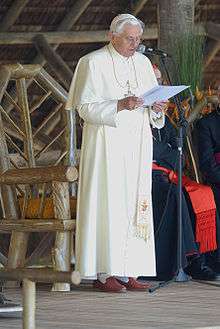Fascia (sash)

The fascia is a sash worn by clerics and seminarians with the cassock in the Roman Catholic Church and in the Anglican Church. It is not worn as a belt but is placed above the waist between the navel and the breastbone (sternum). The ends that hang down are worn on the left side of the body and placed a little forward but not completely off the left hip.
Use
The fascia is not a vestment, but is part of choir dress and is also used in more solemn everyday dress.
Colours
The pope's fascia is white. Only the pope may have his coat of arms placed on the ends of the fascia that hang down near or past the knees. The fascia worn by cardinals is scarlet-red watered silk. The fascia worn by nuncios within the territories assigned to them is purple watered silk.[1] The fascia worn by patriarchs, archbishops, bishops, protonotaries apostolic, honorary prelates, and chaplains of His Holiness is plain (not watered) purple. The fascia worn by priests, deacons and seminarians is black, while the fascia worn by priests in the service of the Papal Household is black watered silk.
Forms
Prior to the changes that followed the Second Vatican Council there were two types of fascia: the tufted fascia, on which each end was finished in a single large tassel, and the fringed fascia, on which each end is straight and finished with fringe. The Instruction Ut sive sollicite of the Secretariat of State, dated 31 March 1969,[2] declared that "the sash with tassels is abolished" for cardinals,[3] bishops,[4] and "Prelate Superiors of the Dicasteries of the Roman Curia who do not have the episcopal dignity, the Auditors of the Sacred Roman Rota, the Promotor General of Justice and the Defender of the Bond in the Supreme Tribunal of the Apostolic Signatura, the Protonotaries Apostolic de numero, the Clerics of the Apostolic Camera and the Prelates of the Pontifical Antechamber".[5] This Instruction did not deal with canons,[6] some few of whom have retained the tufted sash to which membership of their particular chapter entitled them.
References
- ↑ Instruction Ut sive sollicite, 32
- ↑ Text of the Instruction in English, published by L'Osservatore Romano
- ↑ Instruction, 3
- ↑ Instruction, 15
- ↑ Instruction, 18
- ↑ Instruction, 35